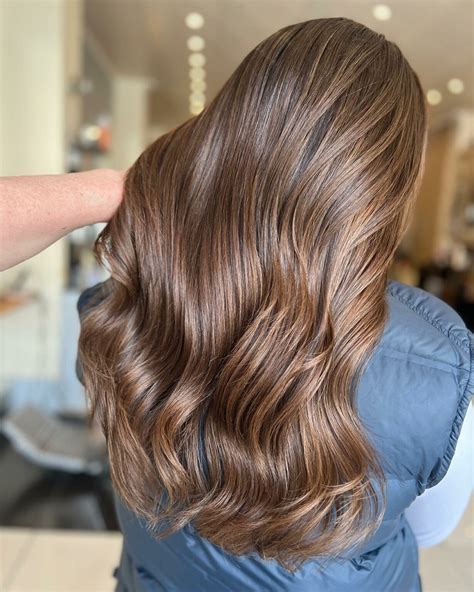Embrace the warm and inviting glow of hazelnut hair dye, a shade that has captured the hearts of countless hair enthusiasts. Whether you’re seeking a subtle transformation or a bold statement, hazelnut offers a versatile and stunning option.

Understanding Hazelnut Hair Dye: The Basics
Hazelnut hair dye typically falls within the light to medium brown color range, featuring warm undertones reminiscent of roasted hazelnuts. This shade can complement a wide spectrum of skin tones and eye colors, making it a universally flattering choice.
Benefits of Hazelnut Hair Dye
-
Natural and Versatile: Hazelnut hair dye provides a natural-looking enhancement that blends seamlessly with various hairstyles and textures. Its adaptability makes it suitable for both subtle and dramatic transformations.
-
Warmth and Radiance: The warm undertones of hazelnut hair dye impart a flattering glow to the complexion, creating a youthful and radiant appearance.
-
Complements Many Skin Tones: Hazelnut hair dye complements a range of skin tones, from fair to medium to olive. It can enhance warm undertones in the skin and create a harmonious balance.
Choosing the Right Hazelnut Hair Dye for You
To select the perfect hazelnut hair dye shade, consider the following factors:
-
Natural Hair Color: Your natural hair color will influence the intensity and tone of the dye. Darker hair may require multiple applications or a bleaching process to achieve the desired result.
-
Skin Tone: Opt for a hazelnut shade that complements your skin tone. Warm skin tones suit warmer hues, while cooler skin tones benefit from slightly ashier shades.
-
Personal Style: Determine whether you prefer a subtle enhancement or a more transformative look. Choose a lighter shade for a natural boost or a darker shade for a bolder statement.
DIY vs. Professional Hazelnut Hair Dye: Which is Right for You?
-
DIY Hazelnut Hair Dye: Home hair dyeing offers convenience and affordability. However, it requires precision and attention to detail to achieve the desired results.
-
Professional Hazelnut Hair Dye: A professional colorist can provide expert guidance, ensuring even application and optimal shade selection. This option may be more suitable for complex transformations or if you have previous hair color history.
Application Tips for Hazelnut Hair Dye
Whether DIY or professional, follow these tips for successful hazelnut hair dye application:
-
Strand Test: Perform a strand test on a small, inconspicuous section of hair before applying the entire dye to test the color and minimize the risk of allergic reactions.
-
Protect Your Skin: Apply a thick layer of petroleum jelly or coconut oil around your hairline and ears to prevent staining.
-
Even Application: Use a brush or comb to distribute the dye evenly throughout your hair, ensuring thorough coverage from roots to tips.
-
Processing Time: Follow the manufacturer’s instructions for the recommended processing time. Overprocessing can damage your hair, while underprocessing may not achieve the desired color.
Common Mistakes to Avoid
-
Overlapping Hair Dyes: Avoid applying new hazelnut hair dye over previously dyed hair without removing the old color first. This can lead to uneven results and potential color clashes.
-
Using the Wrong Developer: The developer is an essential component of the hair dye process. Ensure you’re using the correct developer strength for your hair type and the desired color intensity.
-
Insufficient Bleaching: If you have dark hair and aim for a light hazelnut shade, bleaching may be necessary to remove underlying pigments. Insufficient bleaching can prevent the hazelnut dye from fully absorbing.
Frequently Asked Questions (FAQs)
-
Can hazelnut hair dye be mixed with other hair dyes? Yes, it can be mixed with other shades of brown, gold, or reddish hues to create a customized color.
-
How often should I re-dye my hair with hazelnut dye? The frequency of re-dyeing depends on the growth rate of your hair and the desired intensity of the color. Generally, touch-ups may be needed every 4-8 weeks.
-
Can I use hazelnut hair dye on bleached hair? Yes, you can apply hazelnut hair dye to bleached hair, but it’s important to use a low-volume developer to avoid damage.
-
Is hazelnut hair dye permanent? Most hazelnut hair dyes are semi-permanent or demi-permanent, meaning they will gradually fade over time.
-
How can I determine my hair porosity to choose the right hazelnut hair dye? Hair porosity refers to the hair’s ability to absorb moisture. Conduct a porosity test by dropping a few drops of water on a clean strand of hair. If the water absorbs quickly, you have high porosity hair, which requires a lower developer strength. If the water rolls off, you have low porosity hair, which needs a higher developer strength.
-
Can I use hazelnut hair dye on gray hair? Yes, hazelnut hair dye can be used to cover gray hair. However, you may need to bleach the gray hair first or use a stronger developer to achieve full coverage.
Conclusion
Embrace the nutty allure of hazelnut hair dye, a versatile shade that flatters a wide range of hair colors, skin tones, and personal styles. Whether you’re aiming for a subtle enhancement or a transformative look, choose a hazelnut hair dye that complements your natural features and follow the application tips for a flawless result. Remember to avoid common mistakes, consult a professional if needed, and enjoy the radiant warmth and sophistication of hazelnut hair.
